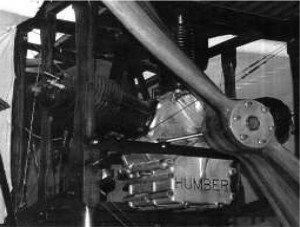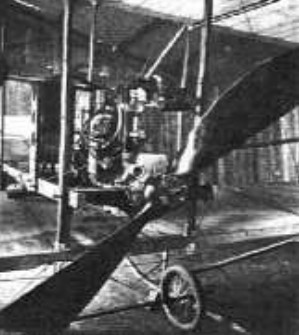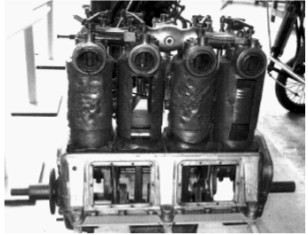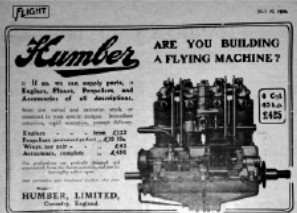Updated: 29-May-2019
Coventry automobile manufacturer.
-In 1918 Humber received the contract to manufacture 850 Dragonfly MK1 ABC engines, although they did not have time to deliver any before the end of WWI that occurred immediately.
-In 1908 a car engine of this brand was used on the Barnwell biplane.
-In 1909 the 4-cylinder, water-cooled, 50 hp engine was used on the Edwards Rhomboidal.
-At the RAF Museum in England there are a 40 hp and a 35 hp (at 1,200 rpm) exposed.
-Below we show a photograph of another Humber three-cylinder engine with a specially aviation design. It is exhibited at the Midland Air Museum.

“Three-cylinder Humber engine”
From Appendix 6: A Humber four-cylinder inline engine that gave 45/50 hp was installed on a participating aircraft at the Rheims Flying Grounds in June 1910.

“Photo of an installed Humber engine”
-The one in photography above was water cooled. Another engine, the 30 hp with three cylinders, was air cooled. Both were at the 1910 Paris Air Show (Stand 53).
-The Barnwell plane was powered by a 40 hp Humber TT car engine. This engine had four inline cylinders and was water cooled.
-The three-cylinder, air-cooled Humber engine reappears on the Humber-Le Blon. It was fan-shaped and gave 30 hp.

“The 3-cylinder Humber on Le Blon” (PeT-fmr)
-This three-cylinder engine is mentioned in the main text, there is even an illustration.
-We have received -by JGB- a photo of the 35 hp, four-cylinder at the mentioned RAF Museum. In the picture the red copper outer sleeves appear badly hit.

“Humber 4 cylinder”
-On the explanatory panel is said that a four-cylinder Humber intervened in the prize for best engine known as the Patrick Y. Alexander Contest.
-As a curiosity, during the 24-hour, full-power (35 hp) test, it failed because of a blown-off cylinder head.
-The other two engines from other brands also failed in this 1910 test.
-As it is said in this publication, Humber was commissioned to build 850 Dragonfly ABC engines in the war effort, not delivering any at the end of the war in 1918.
-Curiously, on the same museum panel it is said that the Dragonfly gave a disastrous result.
-But the construction of the Humber-Bentley Rotary BR.1 and BR2 proved reliable.
From Appendix 10: Below we show an ad on the 4-cylinder, inline engine that appeared in a 1910 Flight magazine.

“Humber engine ad in Flight”
From Appendix 12: Below we show the engine with three cylinders in fan-shape giving 30 hp.

“Humber 3-cylinder fan-shape”
-Unlike Anzani it has the crankcase and oil tank clearly identified.
Engines of HUMBER
Model: 3 cyl, semi-radial, 30 HP
Arquitecture: 3-cylinder Fan-shape
Cooling: Air
Total Displacement:
Bore / Stroke:
Power: 30 HP
Weight:

"Humber 3-cylinder, fan-shape engine"
Model: 4 cyl. inline
Arquitecture: 4-cylinder In-line
Cooling: Liquid
Total Displacement:
Bore / Stroke:
Power: 50 HP
Weight:

"Humber 4-cylinder engine"
Model: ABC Dragonfly (Lic.)
Arquitecture: 9-cylinder Radial
Cooling: Air
Total Displacement:
Bore / Stroke:
Power: 340 HP @ 1650 rpm
Weight: 600 Lb
Model: Auto TT, 4 cyl. inline, 40 HP
Arquitecture: 4-cylinder In-line
Cooling: Liquid
Total Displacement:
Bore / Stroke:
Power: 40 HP
Weight:


